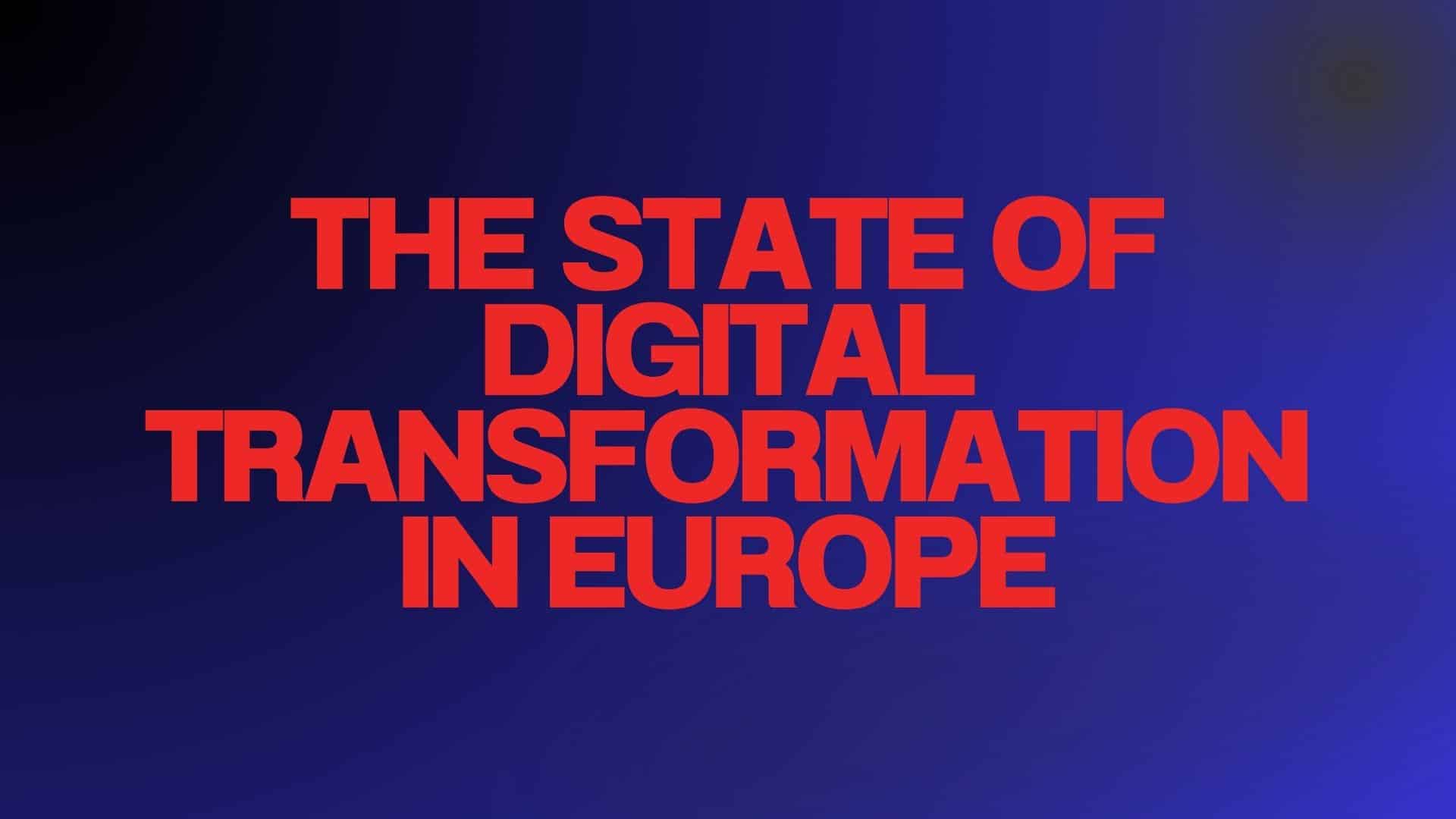If you’re leading a digital transformation in Europe right now, you’re under pressure from every direction: vendors pushing cloud, boards pushing cost control, regulators pushing new obligations, and the market pushing speed. I spend most of my time inside that tension, working with private equity-backed groups, multinationals, and mid-market firms across the UK and EU, and I’ll be blunt:
This is not a normal cycle.
This is a moment to slow down, get sober, and protect the business.
Below is how I see the landscape as of 2025: what’s actually happening on the ground, where the biggest risks are, and why in many cases, the smartest move is to pause rather than charge ahead.
Table of Contents
ToggleWe’ve Been Here Before (Sort Of)
People talk about “the future” of technology as if we’re marching in a straight line towards something better. I don’t buy that.
When I started in IT in the 1980s, we ran on big centralised mainframes. Then the world swung hard towards distributed, client/server, “open systems”, on-premise stacks. Everything was going to be agile and flexible and ours to control.
Now we’ve circled back. Cloud and software-as-a-service have put critical systems right back on central platforms, except the “mainframes” now belong to hyperscalers and mega-vendors. Your core applications, data, identity, even compliance posture, all sitting under someone else’s roof.
Has it all improved? In some ways, yes. In other ways, absolutely not.
In 1984, if a mainframe went down, you got it back in a day. If you didn’t, you were fired. Business continuity planning was table stakes.
Today, some very large organisations in the UK and EU have been taken out by cyber incidents for weeks or even months. We’ve seen national-scale services dependent on a single cloud provider go dark for days. The level of dependence on central infrastructure has skyrocketed, but the resilience and recovery discipline have not kept pace.
That’s the uncomfortable truth: we’ve offloaded ownership of risk, but not the consequences.
Cost Is Driving Behaviour, and Risk
Let’s be honest about why boards and CIOs are being sold so hard on cloud and “as-a-service” models: cost.
It’s cheaper (on paper) to outsource infrastructure, platform management, upgrades, patching, performance tuning, and so on. You don’t have to run data centres or keep entire support teams in-house. So you move to hyperscale providers, you move to subscription models, and you tell yourself you’re now “modern”.
The catch is control.
The moment you push your core processes, finance, procurement, fulfilment, manufacturing, HR — onto a vendor’s platform, you’ve tied your operating model and your compliance posture to their commercial terms, their roadmap, their politics, and their outage profile.
That’s fine until it isn’t.
And this is where Europe is waking up faster than other regions, in my view. We’re now at a point where regulators, investors, and audit committees are starting to ask the harder question: not “is it cheaper?”, but “what does it expose us to?”
The SAP Situation: Pressure, Resistance, and a Brewing Fight
Let’s talk plainly about SAP, because this is one of the most consequential shifts happening in Europe right now.
A huge number of established organisations in Europe still run SAP ECC. It’s mature, it’s stable, it’s heavily tailored, and in many cases it literally encodes the company’s intellectual property: pricing logic, manufacturing sequences, compliance routing, localisation workarounds, industry nuances, all embedded over 10, 15, 20 years.
SAP, of course, wants those customers to move to S/4HANA, preferably in the cloud. They’ve announced end-of-support dates for ECC and keep insisting the future is HANA, “clean core”, AI, Fiori apps, and so on.
Here’s what’s actually happening in boardrooms:
- Most large European enterprises are not eager to move.
- Many are openly refusing.
- Some are only moving because they’ve been cornered by a structural event (for example, a divestment or carve-out).
Why the resistance?
1. Risk.
Moving from ECC to S/4HANA is not an upgrade. It is, in most cases a reimplementation of your operating model on a less flexible platform. We’re currently recovering several S/4 programmes in Europe that have gone sideways. Not because the client is incompetent, but because the shift from “the way ECC lets us work” to “the way SAP wants us to work” is massive.
2. Loss of differentiation.
Companies have spent years building a real competitive advantage into ECC. SAP’s “clean core” story sounds nice until you realise it basically means: stop customising and run your business the way SAP thinks your industry should run. That’s fine if you’re average. It’s a problem if your margins depend on not being average.
3. Commercial posture.
SAP’s licensing and liability terms for S/4HANA (particularly in cloud scenarios) are, frankly, becoming unpalatable for a lot of CFOs and private equity owners. In some cases, we’ve seen liability language so aggressive that clients have walked away purely on legal and financial exposure, before we’ve even talked about technology.
4. The support deadline isn’t the full story.
SAP is telling the market, “ECC support ends, time’s up.” But in Europe, there’s now real regulatory pressure on that position. The EU has begun looking into whether SAP is creating anti-competitive conditions around support and third-party maintenance. Large enterprises have lobbied Brussels because they’re effectively being pushed into an expensive migration they don’t want, on terms they don’t accept. That is not a small thing.
Add to that the fact that third-party support providers are offering extended maintenance for ECC well beyond the official SAP cut-off, in some cases into the 2030s and reportedly even the 2040s, and the urgency argument starts to weaken.
So, no: you’re not “reckless” if you haven’t leapt to S/4HANA yet. In many cases, you’re being prudent.
AI: The Hype vs the Reality
Now let’s address the other pressure narrative: “AI will transform your ERP.”
Will it? Not in the way you’re being promised.
There are two parallel truths here:
Truth 1: AI is useful in specific, well-bounded areas.
Things like demand forecasting, route optimisation, dynamic replenishment, invoice capture, anomaly detection in receivables; these are areas where machine learning and pattern analysis can absolutely outperform humans. We’ve seen genuinely strong use cases in finance operations and planning-heavy supply chain environments.
Truth 2: Generative AI and large language models are wildly oversold.
What most vendors are pitching now as “AI” inside ERP is just a chatbot with nicer clothes. It does not understand context. It does not truly reason. It does not carry commercial accountability. And it absolutely does hallucinate, confidently.
If you’ve ever fought with a virtual assistant that refuses to solve a basic service issue and won’t hand you to a human, you already know the truth: we are still at the “annoying toddler” stage of applied AI in enterprise workflows.
Here’s the dangerous bit: some vendors are now saying, “You only get these AI capabilities if you move to our latest cloud suite.” So AI becomes a forcing function to drive cloud migrations. That is not innovation. That is a sales strategy.
My view for European organisations is this:
- Don’t chase AI for the sake of “not being left behind.”
- Do identify 1–2 narrow, measurable operational use cases where predictive capability or pattern recognition can directly reduce cost, reduce working capital, or improve service reliability.
- Treat everything else as noise until proven otherwise.
The European Mindset: Conservative, and Correct
Compared to North America, European boards tend to be more conservative. There’s more regulatory scrutiny. There’s more concern about exposure and continuity. There’s more pressure from works councils and unions. And there’s often more complexity in operating models (multi-country, multi-language, multi-entity).
That caution is, right now, an advantage.
We’re seeing clients in the UK, DACH, Nordics, Benelux, Southern Europe and beyond asking harder questions than they were, say, five years ago:
- “What do we actually gain by moving core finance from what works to something new?”
- “Are we giving away leverage to a single vendor we can’t negotiate with later?”
- “Can this supplier lock us into terms that become a balance sheet risk?”
- “Will we still even own our own way of working?”
Those are the right questions.
And in many cases, the answer we’re giving is:
Not yet. Wait.
“Wait” Doesn’t Mean “Do Nothing”
When I advise clients to pause, I don’t mean sit still indefinitely, ignore tech and hope for the best. I mean: don’t let a vendor’s urgency become your urgency.
Here’s what to do in the meantime:
1. Sweat the assets you already have.
Your current ERP, even if it’s “old”, likely has unused capability. In many organisations, the process is broken, not the system. Improve process discipline, master data hygiene, and internal controls before you assume the system must be replaced.
2. Stabilise your estate.
Clean up interfaces. Document critical customisations. Tighten access security. Sort out backup and recovery. You’d be shocked at how many firms are exposed on basic resilience because they’ve been told, “Don’t worry, we’ll fix it all in the new platform.” Then the “new platform” drifts for two years.
3. Build your business case like an adult.
If you do eventually move to S/4HANA, to Microsoft Dynamics 365, to Oracle Fusion, to Workday, whatever, you should be able to prove in pounds and euros (not buzzwords) why it’s worth it. That proof should be a measurable operating value, not “we’ll get AI” or “SAP said we have to”.
4. Protect your negotiating position.
Watch the legal language. We’re seeing liability, audit, and licence exposure quietly creep into cloud terms that in some cases are simply not acceptable for a PE-backed or publicly traded business. Do not sign that away lightly.
My Advice to European Leaders Right Now
If you’re about to greenlight a large digital or ERP transformation in 2025/2026, here’s my honest guidance:
Pause briefly.
Look past the sales narrative.
Get clear on risk, not just ambition.
There’s a huge amount of volatility in the market: commercial, technical, legal, regulatory. We’re also on the edge of what feels like an economic wobble. This is not the moment to bet the company on a vendor’s roadmap that may not even look the same 12 months from now.
Use this window to strengthen the business you’re already running: process, data, resilience, working capital, fulfilment performance, customer responsiveness. Those are transformation levers too, and they don’t require you to hand over your destiny to a platform provider on their terms.
Will the market settle? Of course. It always does.
Will the big vendors adapt? Some will. Some won’t.
Will EU regulation keep changing the rules? Absolutely.
Your job, and ours, when we’re advising you, is to make sure you’re still standing when the dust settles.
If you’re in Europe and you’re being pushed into a digital initiative you’re not fully comfortable with, let’s talk. We can help you separate signal from noise, cut through vendor pressure, and build a strategy that serves your business, not someone else’s quarterly number.





